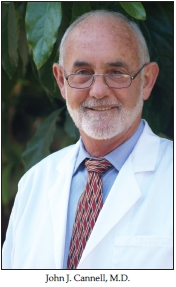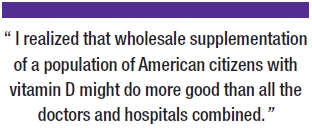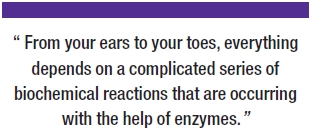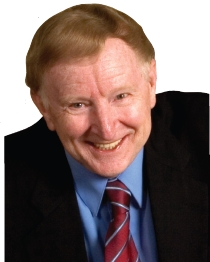The Institute of Medicine (IOM) has published its new recommendation for the dietary intake of vitamin D. The new recommendations contain significant changes from IOM’s previous recommendations in 1997, and current research indicates that even the new changes are already out of date. During the next few months, we will chat with the executive director of The Vitamin D Council, John J. Cannell, M.D., about vitamin D and new research.
Many readers may already be familiar with Dr. Cannell’s impressive record of actively working to improve the health of all people—not just his own patients. We will discuss some of his efforts in a later installment, but let’s start with his educating physicians, scientists and the general population about vitamin D.
Dr. Cannell graduated with a degree in zoology from the University of Maryland, where he was a member of Phi Beta Kappa. He received his M.D. from the medical school at the University of North Carolina. After a year-long surgery internship at the University of Utah and four years of practicing itinerant emergency medicine, he began as a general practitioner in the coalfields of Appalachia.
Later, Dr. Cannell left general practice and went back to school to study psychiatry. He moved to Atascadero, CA, in the late 1990s and began working as a psychiatrist at Atascadero State Hospital, the largest hospital in America for the criminally insane. There, his long-held interest in clinical nutrition was re-awakened. The further he studied nutrition, the more and more vitamin D3 (cholecalciferol) caught his attention.
As Dr. Cannell began to study the effects of vitamin D, he immediately realized that the recommendations of the Food and Nutrition Board (FNB) of the IOM were placing many Americans at risk. He found that vitamin D insufficiency was common in older adults, even using conservative cutoff points for vitamin D blood levels. Dr. Cannell was left wondering whom he should believe, Nature or the FNB? In 2003, he recruited professional colleagues, scientists and friends for a board of directors and took the steps necessary to incorporate The Vitamin D Council as a tax exempt, nonprofit, 501(c)(e) corporation.
In September 2006, Dr. Cannell’s seminal article, “Epidemic Influenza and Vitamin D” was published in the Journal of Epidemiology and Infection. The article presented a revolutionary new theory on vitamin D’s link to influenza and was co-written with some of the world’s top vitamin D experts.
Passwater: Dr. Cannell, why did you become interested in vitamin D?
Cannell: Ten years ago, I saw the possibility that vitamin D might radically change modern medical care. The reason I thought that was possible was, first, the mechanism of action of vitamin D, and second, the fact that people had suddenly stopped doing the things they needed to do to get vitamin D. Because of those two things, I realized that it might be possible to bring about a dramatic change in modern medical care.
Passwater: Well, vitamin D is indeed unique. What did you learn about this uniqueness?
Cannell: Historically, we didn’t depend on vitamin D in foods at all, but now we are increasingly becoming dependent on diet for vitamin D. Over the millennia, humans have gotten their vitamin D mostly from sunlight striking their bare skin. In order to make vitamin D, you must be outside when the sun is high enough overhead. If the sun is low on the horizon, you may tan but you won’t make much vitamin D.
Passwater: How is it made in the skin?
Cannell: The vitamin D precursor in our skin is 7-dehydrocholesterol, which is made in the body from cholesterol. Ultraviolet-B (UVB) energy converts 7-dehydrocholesterol into cholecalciferol, which is the name of natural vitamin D. Cholecalciferol (pronounced koh· luh· kal· sif· uh· rawl) is then carried in the bloodstream to the liver, where it is  converted into the prohormone 25-hydroxy vitamin D (calcidiol). Some of that 25-hydroxy vitamin D is then transported to the kidneys where it is hydroxylated further to form 1,25-hydroxy vitamin D (calcitriol). This form is the physiologically active form of vitamin D. The calcitriol made in the kidneys is to fulfill only one of vitamin D’s functions: its endocrine function, which is to maintain the calcium economy.
converted into the prohormone 25-hydroxy vitamin D (calcidiol). Some of that 25-hydroxy vitamin D is then transported to the kidneys where it is hydroxylated further to form 1,25-hydroxy vitamin D (calcitriol). This form is the physiologically active form of vitamin D. The calcitriol made in the kidneys is to fulfill only one of vitamin D’s functions: its endocrine function, which is to maintain the calcium economy.
Technically not a “vitamin,” vitamin D is in a class by itself. Its second metabolic product, 1,25-hydroxy vitamin D (calcitriol), is actually a hormone, a key that fits binding sites on the human genome. The human genome contains more than 2,700 binding sites for 1,25-hydroxy vitamin D; those binding sites are near genes involved in virtually every known major disease of humans.
Passwater: No wonder vitamin D is the focus of so many disease-related studies. It seems to be involved in almost everything.
Getting back to the effect of position of the sun and the production of vitamin D, is this because it takes more UV energy (in terms of photons per unit of time or surface area) to convert 7-dehydrocholesterol to vitamin D, or does the conversion require a different energy in terms of wavelength?
Cannell: Vitamin D3 is made in the skin when 7-dehydrocholesterol reacts with UVB at wavelengths between 270 and 300 nm, with peak synthesis occurring between 295 and 297 nm. A large number of these wavelengths are present in sunlight when the sun is high enough that your shadow is shorter than you; otherwise, the ozone in the atmosphere prevents UVB radiation from penetrating the atmosphere.
Passwater: You mentioned that time of day is critical in producing vitamin D in skin, but latitude and time of year also play roles. At 42 degrees latitude, the sun’s energy at noon is only 75% of the energy at the equator (SIN 48) at that time. The noonday sun in Florida is more intense (i.e., more UV photons per square inch) than the noonday sun in New York, so New Yorkers need more time in the sun to make their vitamin D. A beam of noon sunlight is spread out further (thus has fewer photons of UV energy per square inch) in Chicago than in Peru. In Chicago, the noon sunlight is at 42 degrees north latitude and has an angle of 42 degrees; in Peru, the noon sunlight is at three degrees south latitude, which makes the sun angle 87 degrees.
 Cannell: Yes, that’s right. Also, think of UVB photons as ping pong balls. They bounce around. They bounce off buildings, sand, water, even the bottom of clouds, until they hit something that absorbs them, like your skin. That’s why you can make vitamin D under a sun umbrella at the beach.
Cannell: Yes, that’s right. Also, think of UVB photons as ping pong balls. They bounce around. They bounce off buildings, sand, water, even the bottom of clouds, until they hit something that absorbs them, like your skin. That’s why you can make vitamin D under a sun umbrella at the beach.
Passwater: Well, the sun and Earth haven’t changed much, and skin hasn’t changed much. What has changed?
Cannell: More people used to work outside, which enabled them to get plenty of vitamin D and store it up for the winter time. In the last 50 years, we started living inside virtually all the time. In the last 25 years, we basically stopped going out in the sun at all. People have changed their minds about the sun; it is now considered “evil.” When you and I were growing up, our mothers told us that sunshine and fresh air were good for us. You never hear that anymore. Now, sunshine is a bad thing!
That was just one of several things that occurred. Others were the introduction of indoor video games and the fear that children should not be outdoors because predators might abduct them. Then, there was the fear that the sun would damage the skin. All these things affected our society in dramatic ways.
Starting in the 1980s, for the first time in human history, doctors began telling patients to avoid the sun. Up until that time, the sun was recognized as a curative agent by every form of medicine known to  man. Then, the American Medical Association and their Council for Scientific Affairs started saying something very different: the sun is harmful, stay away from it. It is interesting what they didn’t say: “By the way, since you are not going out in the sun, you need to take 5,000 units of vitamin D/day to make up for your lack of sun exposure.”
man. Then, the American Medical Association and their Council for Scientific Affairs started saying something very different: the sun is harmful, stay away from it. It is interesting what they didn’t say: “By the way, since you are not going out in the sun, you need to take 5,000 units of vitamin D/day to make up for your lack of sun exposure.”
In fact, they actually said it won’t matter because vitamin D will remain the same whether or not you go in the sun, which is a patently absurd statement. So, I said to myself, with the dramatic change in sun exposure over the last 25 years, vitamin D levels must have fallen dramatically in at least some, but probably many, people.
Passwater: Your points are well taken. What was the second factor that aroused your concern about and interest in vitamin D?
Cannell: Vitamin D is not a vitamin; it is a seco-steroid hormone. It works by directly regulating about 1,000 human genes, which is about 5% of the human genome.
Passwater: Amazing! Thirty-five would be a very decent number of genes to regulate. Two hundred would be an enormous amount. But, 1,000 is mind-boggling!
Cannell: People sometimes think that their genes are inherited, carried around and then passed on to their children, which is all the genetics they know. They don’t think about what their genes do between the time they are inherited and the time they are passed on to their children. Genes are the brains of your body more than your brain is. You can only read this now because your genes are working, making the enzymes that the eyes and brain need to conduct the immensely complicated biochemical task we call reading.
In other words, your genes are regulating your body’s proteins including the enzymes and proteins involved in vision. Genes are the conductors that allow your brain to work as you read this.
A large percentage of the human genome, maybe up to 2,000 human genes when including indirect control, are controlled by vitamin D. Without vitamin D, those genes literally do not know what to do. They don’t know whether to increase or decrease the production of their particular enzyme. Vitamin D can turn a gene on or off. The genes don’t know what to do without vitamin D.
So, you can see that once you understand the mechanism of action of vitamin D (i.e., that it turns hundreds of genes on and off and regulates them), then you can say, “Oh, that’s the reason that vitamin D can be involved in the eyes in macular degeneration, and teeth as in dental caries, in the heart in heart attacks or involved in bone, breast, colon and prostate health, in the pancreas and diabetes and so on,” which brings us to the “triple-A epidemics” raging among our children: autism, asthma and autoimmune disorders.
In my opinion, vitamin D deficiency during pregnancy and early childhood is the principal cause, actually the principal trigger, of autism. There are doctors at Harvard who think childhood vitamin D deficiency is also the cause of the childhood asthma epidemic, and other doctors have written that vitamin D deficiency during pregnancy and early childhood is involved in the epidemic of autoimmune disorders such as insulin-dependent diabetes mellitus, which has increased dramatically among our children.
Passwater: Interesting observations indeed. We’ll certainly chat more about them in Part 3. So, we have a vitamin that is not a vitamin, but a very potent and multi functional hormone.
Cannell: Yes, vitamin D is like a key to a lock.
What vitamin D does is directly unlock about 1,000 human genes. This is even more curious in that it is dependent on human behavior. In all other cases that I can think of, something as important as vitamin D would never be left up to the choice of the organism. The human organism would evolve a way to make it if it was needed, without relying on human behavior. But if you need vitamin D, you can’t make it unless you do one thing: go outside and allow UVB radiation to strike your skin.
For millennia, we were never out of the sun. Humans were always in the sun. Nature could not conceive of the possibility that humans would banish sunshine. However, starting with the Industrial Revolution, we began working inside, but we still had vegetable gardens. We still walked around outside and rode horses. Then, cars came along and we started driving in vehicles with glass windows. Ordinary glass completely blocks UVB. Even if it is a very sunny day at solar noon, as you drive your car with your windows up, you’re not making a bit of vitamin D because of the glass.
Soon, more and more people came off the farm to work in factories. Even people who worked on farms started using tractors that had glass windows like cars. Changes kept occurring that reduced our UVB exposure and lowered vitamin D levels.
Then, came the three events that I already mentioned: the fear of child predators, video games and skin cancer, with the ultimate order by the American Medical Association (AMA) that pregnant women should not go out in the sun, mothers should not go out in the sun, children should not go out in the sun and adults should avoid the sun. If you had to go outside, always put on sunblock. I predict that particular piece of AMA advice will go down in history as the single most lethal piece of medical advice ever given.
Sunblock can be very effective in preventing vitamin D formation. The only good news is that very few people apply sunblock properly. You have to use a lot of it to block out all the UVB radiation. However, now people are using SPF 60 and 80, which means they’re very effective sunscreens.
So, what I realized was that intracellular levels of this substance—this steroid hormone called vitamin D—had been dramatically decreased in people over the last 25 years. At the same time, the “triple-A epidemics” began to occur among our children.
Passwater: You have been doing an excellent job of educating other scientists about these three new epidemics. You have put together many very interesting facts about vitamin D deficiency and autism. Our readers will certainly want to read Part Three of this article, where you tell us more about this.
Cannell: When I say epidemics, in 1970 it was rare to see a child with insulin-dependent diabetes mellitus, asthma or autism. Now, everybody knows kids with those disorders. It has increased dramatically and shows no sign of stopping. For example, the National Institutes of Health reported about nine months ago that if you have a male child born this year, that boy will have about a 1 in 60 chance of developing autism before he is eight years old. One in 60! It used to be that a typical psychiatrist would never see a case of autism in his/her whole 40 years of practice.
Passwater: Well, we can see why you became interested in vitamin D. Why did you then go on and organize The Vitamin D Council?
Cannell: As you know, I have always been an activist on issues such as smoking, black lung disease, public education school reform and a number of other things. I realized that wholesale supplementation of a population of American citizens with vitamin D might do more good than all the doctors and hospitals combined. When I discovered that this was a possibility, I knew that I had to do something.
If you need to do something, you need resources. I started The Vitamin D Council with the help of a group of concerned citizens and scientists who believe many humans are needlessly suffering and dying from vitamin D deficiency. We have been incorporated as a nonprofit, tax-exempt 501(c)(e) educational corporation in the state of California since 2003.
Our goal is to educate the public and professionals about vitamin D deficiency and its numerous associated diseases. Our free Vitamin D Newsletter has a circulation of over 40,000 and is growing. The Vitamin D Council would like to sponsor a series of educational conferences aimed at the general public, physicians and the press to alert them about the extent and consequences of vitamin D deficiency and the simple steps that can be taken to avoid it.
Sometime in 2002, my son and I created The Vitamin D Council Web site,www.vitamindcouncil.org. This Web site now receives over 5,000 unique visitors each day. When someone does a vitamin D search on Google, our Web site usually is in the top three or so responses. We will have a brand new, radically different, Web site coming online by the end of May.
Passwater: Well, The Vitamin D Council has been extremely effective in educating the general public and scientists alike. You have also been cost-effective. When vitamin D started creeping out of its rather boring dormancy in the past decade, I thought it was time for me to bring this to the attention of our readers. But almost overnight, vitamin D became a media sensation, and there was no need for me to discuss it here. However, the IOM’s new recommendations changes that. Yes, I would say The Vitamin D Council has been very effective.
Cannell: I needed a vehicle to try to get the word out about vitamin D. Our monthly e-newsletter helps with that endeavor. Anyone can sign up to receive this free newsletter on www.vitamindcouncil.org.
Passwater: I find your newsletter very informative and interesting. Isn’t it expensive to maintain the Web site and other Vitamin D Council resources?
Cannell: We certainly need charitable donations. We are a nonprofit organization. The more donations we receive, the more public service announcements we can make and the more people we can inform. We try to run most of our public service announcements in the fall and winter, when people are most vitamin D deficient.
Passwater: How can someone make a donation?
Cannell: If someone would like to send a contribution, check made out to Vitamin D Council can be sent to: The Vitamin D Council, 1241 Johnson Ave. #134, San Luis Obispo, CA 93401. Donations can be made on our Web site using the PayPal donate button. Thank you for your support.
Passwater: You mentioned that vitamin D was unique in that it interacts directly with genes. Just how does vitamin D interact with the genome?
Cannell: The basic genomic interaction mechanism is fairly well known. Sitting on top of the genes to which vitamin D is responsive is something called the vitamin D response element. Close to the vitamin D response element is a vitamin D receptor. For vitamin D to work, it must combine with a molecule of vitamin A; this combination transforms the vitamin D receptor and locks onto the vitamin D response element. The gene then becomes activated (i.e., down-regulated/up-regulated or turned on/off).
Unfortunately, when some people hear or read that a molecule of vitamin A is also involved with vitamin D action, many people incorrectly assume that they should also take more vitamin A or cod liver oil. Don’t! I have written several papers about vitamin A toxicity in the United States. I think that retinol, the preformed vitamin A, is consumed in toxic amounts in this country. Humans have a profound ability to make all the preformed vitamin A that they need from the carotenoids found in colorful fruits and vegetables.
In fact, two molecules of vitamin A can combine to weakly stimulate the vitamin D receptor. This action of the combined vitamin A molecules blocks the desired strong interaction of the vitamin D–vitamin A combo. This, in essence, prevents the vitamin D mechanism from working. I find that the amounts of vitamin A consumed by humans in the United States are far greater than the vitamin D consumed. We consume much more vitamin A than experts think is healthy, yet the government doesn’t change its advice or take steps to reduce vitamin A fortification of food.
When you eat retinol—the preformed vitamin A that is found in foods such as eggs, liver, butter or milk—it is like injecting vitamin A directly into your vein. But, when you eat beta-carotene, it must go through your intestines and the intestinal cells will sense the amount of vitamin A in the blood. If you have enough vitamin A in your blood, your intestinal cells will not convert the beta-carotene into vitamin A. The beta-carotene or other carotenoids will not be converted into retinol, so the rate-limiting mechanism is in the intestine. If you take retinol, the preformed vitamin A, like in cod liver oil (not whole-body fish oil), you can easily reach harmful or toxic levels of vitamin A. Excessive vitamin A interferes with the action of vitamin D. Don’t take cod liver oil or supplements high in retinol, the preformed vitamin A. You can get all of vitamin A you need from colorful fruits and vegetables. Many supplements use beta-carotene as their source of vitamin A and this prevents the over-production of retinol in your body.
So, there’s plenty of vitamin A in your body for binding with vitamin D. It is the vitamin D molecules that are in short supply. When the two vitamin A and vitamin D molecules combine, they can activate the vitamin D response element and the gene becomes functional.
Passwater: Vitamin D functions by interacting with many hundreds of genes. Please explain to our readers the impact of this.
Cannell: It is really important for people to realize their genes control virtually everything. From your ears to your toes, everything depends on a complicated series of biochemical reactions that are occurring with the help of enzymes. Well, those enzymes are all activated by genes. For me to have the ability to talk to you now, it requires a functioning genome and your genome cannot function optimally unless you have enough vitamin D. It is the key that unlocks the hundreds of vitamin D-dependent genes that are locked away behind a vitamin D response element. It is crucial to understand that your genome is allowing you to live day to day.
Passwater: How about individual differences in vitamin D receptors, the widespread variations called single nuclear polymorphisms (SNP)? Are they an important factor?
Cannell: There are indeed SNPs. When mutations become so common that 10–20% of us have them, they’re no longer called mutations, but are called polymorphisms. There are many shapes of the vitamin D receptor. It appears that some of the vitamin D receptors are more functional than others, although this has never has been properly researched and it’s not clear what this means at this time. There is very little consistent SNP research on vitamin D receptor polymorphisms and the results are not clear at this time.
In all likelihood, variations in any polymorphisms in the vitamin D receptor simply mean more vitamin D is needed by some SNP to activate sufficient numbers of these receptors on the genes. All of the vitamin D receptor polymorphisms are functional; it is not as though some work and some don’t. However, variation in the functionality of these polymorphisms is one of the reasons why we recommend a 25-hydroxy-vitamin D level of 50 ng/ml in the blood rather than the IOM’s recommendation of 20 ng/ml. We want to be sure everyone gets a benefit.
Passwater: Let’s look at how you and most scientists arrive at your recommendation and how the IOM arrived at theirs in June’s column. WF
Dr. Richard Passwater is the author of more than 40 books and 500 articles on nutrition. He is the vice president of research and development for Solgar Vitamin and Herb. Dr. Passwater has been WholeFoods Magazine’s
science editor and author of this column since 1984. More information is available on his Web site,
www.drpasswater.com.
Published in WholeFoods Magazine, April 2011










